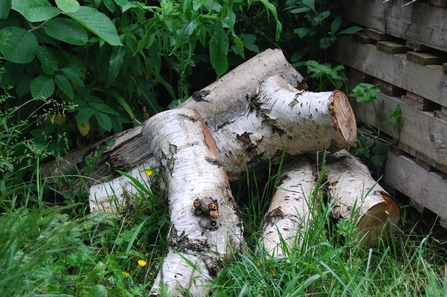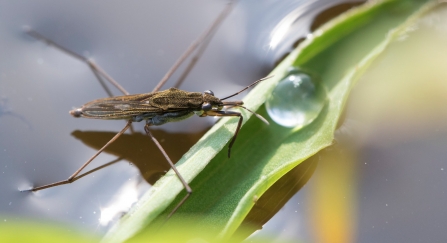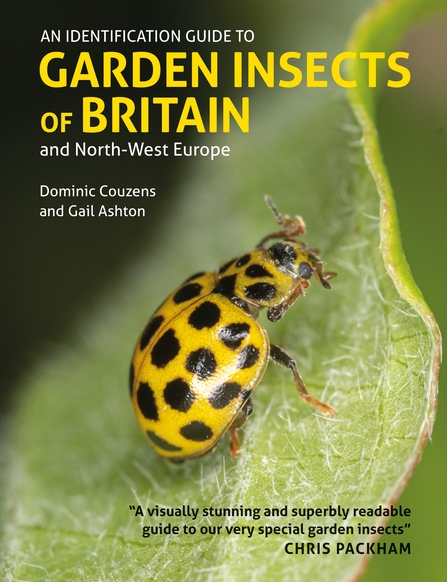Invertebrates are by far our largest taxonomic group, representing around 60% of our wildlife species, locally. Any outdoor space is a potential haven for wildlife and residential outdoor spaces are no exception. Here, photographer and author, Gail Ashton explains how you can help insects to thrive year-after-year and in turn support other wildlife that depends upon them.
A Garden Safari to Help Insects Thrive
(c) Tim Hill

Gooden's Nomad Bee (c) Gail Ashton
It’s high summer, and the air is full of the sights and sounds of insect life. Bees, solitary wasps and hoverflies are busily foraging for nectar; dragonflies and damselflies are hunting for smaller insects and at night moths seek out partners by moonlight. But did you know that our gardens and outdoor spaces play a critical role in the life-cycle of many of our insect species? According to Ordnance Survey, over half a million hectares of the UK is residential garden; an area larger than our national parks combined. This is a huge amount of land, full of potential as food and shelter for our wildlife, and there are some really easy ways to make our outdoor spaces wildlife friendly.
You may be asking why you should you want insects in your garden? Well, if you love birds, hedgehogs, foxes, frogs and bats, then you really do want lots of them! Insects make up a huge part of the diet of mammals and amphibians, and are an indicator of a healthy habitat. It doesn’t matter if your garden is large or small. Even if you don’t have one you can still help our insects around your home.

WildNet - Zsuzsanna Bird
An important way to make your space favourable for flying insects is with flowers. Crocuses and Grape Hyacinth are excellent spring fuel sources. Early bees also love fruit blossom, so if you have the space, why not plant a fruit tree, such as Cherry, or Pear? In summer, insects love composite flowers such as daisies and dandelions, so leave some areas of your lawn unmown, to allow them to flower. The longer grass will also become a shelter for bugs, spiders, bush-crickets and moths. Herbs such as Rosemary, Thyme, Oregano and Mint make a fantastic addition to any garden; they are hardy, adaptable, edible, smell amazing and produce a long season of nectar-rich flowers loved by many species of bees and flies. They also grow just as well in containers as in the ground, so fill your courtyard or balcony up with them! We can even provide winter nectar sources – Mahonia and winter honeysuckles are great fuel stops for the hardy bumblebee queens that can emerge on sunny winter days.

(c) Adam Cormack
Invertebrates such as ground beetles, woodlice and springtails love dark nooks and corners, so build them a log pile with old bits of trunk, branches and twigs. Pile the wood up a corner of the garden and just leave it. You can create it in the sun or shade – both conditions will create contrasting habitats in which contrasting communities will live. Shady wood piles will harbour damp-dwellers, whereas an exposed spot will fill up with bee-flies, wolf spiders, and mining bees, all warming themselves in the warm rays of the sun.

Pond skater © Chris Lawrence
Water is key to biodiversity, and there is the potential to have some form of watery habitat everywhere. Ponds support all manner of aquatic species, such as water beetles and bugs, dragonfly nymphs and dronefly larvae, as well as frogs, toads and even newts. It would be amazing for every garden to have a large pond, but it just isn’t practical for everyone. If you have small children, a trug-sized container sunk into the ground can become a home for many invertebrates, and also a handy watering hole for birds and mammals. A small container filled with pebbles and twigs, surrounded with potted herbs can create a great micro-habitat for hoverflies on a balcony.
Most importantly, be patient. Individuals will only move in when the conditions suit them, and this can take time. Whatever outdoor space you have, whether it be a huge garden, or a tiny balcony, you can make a difference to our wildlife. And whatever you do to support them will reach further than your own home – it will have beneficial consequences for the wider wildlife community and even the entire planet.
How to do even more for insects
For tips and ideas of how you can support insects and encourage other wildlife to visit your garden, check out our Wildlife Gardening pages.
Or, why not take part in the Bugs Matter Survey to share the findings of any journeys you undertake up until 31 August 2023? Find out more here and help us all to learn more about our insect populations.

‘An Identification Guide to Insects of Britain and North-west Europe’ by Dominic Couzens and Gail Ashton is out now, published by John Beaufoy.

